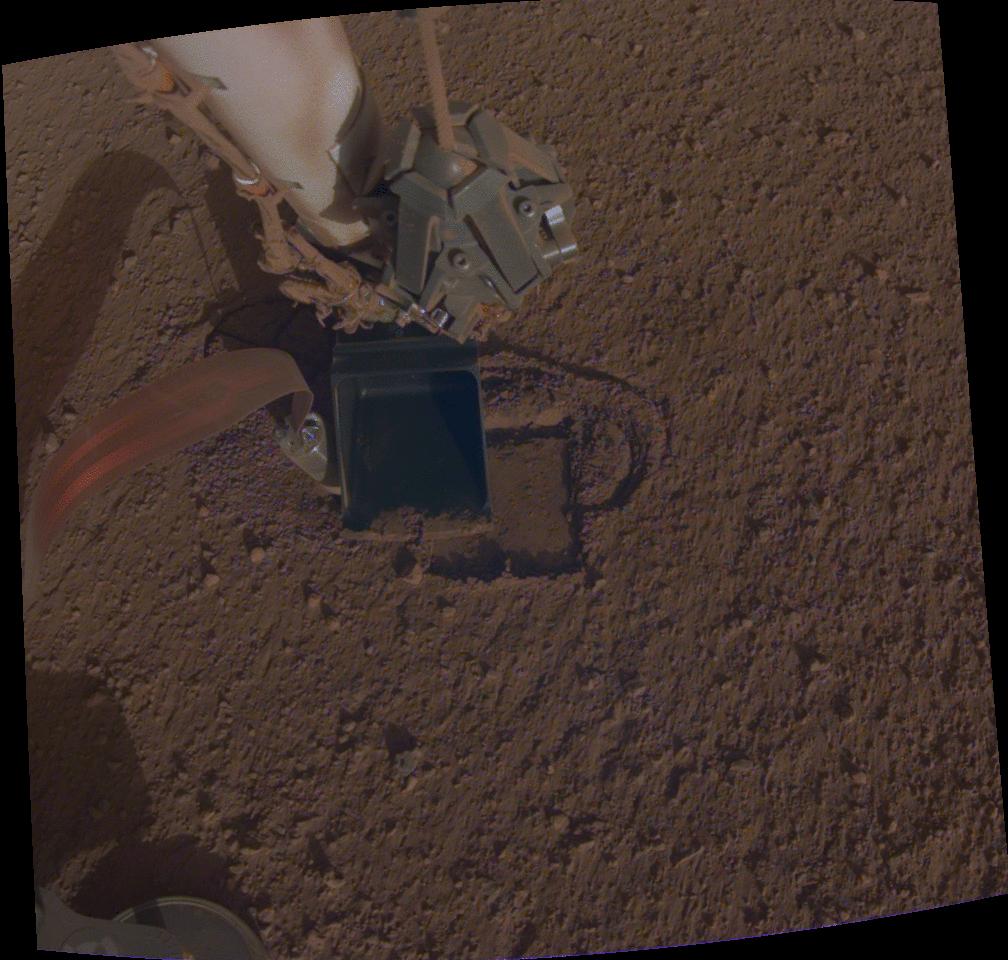
The mole's Mars struggles have not been in vain.
The burrowing heat probe aboard NASA's InSight Mars lander was designed to go 10 to 16 feet (3 to 5 meters) underground, using a self-hammering tool dubbed "the mole." But the mole got stuck just a foot (0.3 m) or so down shortly after its February 2019 deployment and could not be budged for months.
"We scratched our heads for quite a while trying to figure out what we could do," InSight project manager Tom Hoffman, of NASA's Jet Propulsion Laboratory in Pasadena, California, said Friday (Oct. 18) during a presentation at the 22nd Annual International Mars Society Convention in Los Angeles.
Related: Mars InSight in Photos: NASA's Mission to Probe Core of the Red Planet
The InSight team homed in on two possible explanations for the mole's lack of progress: Either there was a big rock blocking its way, or the little digger had lost friction with the Red Planet's soil. Without a good grip on the dirt, the mole can't move much.
Last week, we got some good news: The InSight team had gotten the mole to move a few centimeters using a "pinning" technique, pressing the lander's soil scoop against the mole to create friction. That result showed that hypothesis number two was probably on the money and offered hope that the mole could eventually get down to its prescribed depth.
But even if that doesn't end up happening, the mole will still have taught the team some interesting things about Mars. For example, unlike typical holes dug here on Earth, the one excavated by InSight's mole has no lip of dirt around its rim, Hoffman said.
Get the Space.com Newsletter
Breaking space news, the latest updates on rocket launches, skywatching events and more!
"Where did the soil go?" he said. "Basically, it got pounded back into the ground, so it seems like it’s very cohesive, even though it’s very dusty."
And this is a weird combination of characteristics, strongly suggesting that Mars dirt is alien in more ways than one.
"The soil properties are very different than anything we’ve ever seen on Earth, which is already a very interesting result," Hoffman said.
InSight is probing the Martian interior like never before, helping scientists to create a detailed 3D map of the planet from crust to core. This work will reveal a great deal about how rocky planets form and evolve, mission team members have said.
The lander totes two main science instruments: the burrowing heat probe, which is officially called the Heat Flow and Physical Properties Package (HP3), and a suite of supersensitive seismometers known as SEIS (Seismic Experiment for Interior Structure).
SEIS has already detected 150 seismic events, 23 of which are definitely marsquakes, Hoffman said. But just three of the 23 were larger than a magnitude 3 quake here on Earth, he added.
"So, very many marsquakes, but kind of less substantial than you might expect," Hoffman said.
Most earthquakes are caused by the movement of tectonic plates, which make up our planet's crust. But Mars does not appear to have such plates. The Red Planet's quakes — and those on Earth's moon as well — likely result from continuous cooling and contraction of rock, which cause stress that eventually breaks the crust, according to NASA officials.
- InSight Team Gets Look at Stuck 'Mole' on Mars
- NASA's Mars InSight Lander: 10 Surprising Facts
- Measuring Marsquakes: How NASA's InSight Lander Will Peer Inside Red Planet
Mike Wall's book about the search for alien life, "Out There" (Grand Central Publishing, 2018; illustrated by Karl Tate), is out now. Follow him on Twitter @michaeldwall. Follow us on Twitter @Spacedotcom or Facebook.
Join our Space Forums to keep talking space on the latest missions, night sky and more! And if you have a news tip, correction or comment, let us know at: community@space.com.

Michael Wall is a Senior Space Writer with Space.com and joined the team in 2010. He primarily covers exoplanets, spaceflight and military space, but has been known to dabble in the space art beat. His book about the search for alien life, "Out There," was published on Nov. 13, 2018. Before becoming a science writer, Michael worked as a herpetologist and wildlife biologist. He has a Ph.D. in evolutionary biology from the University of Sydney, Australia, a bachelor's degree from the University of Arizona, and a graduate certificate in science writing from the University of California, Santa Cruz. To find out what his latest project is, you can follow Michael on Twitter.









